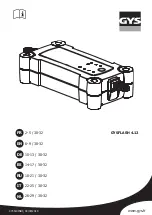
11
Q2 Why was the microcomputer control system adopted for the Model UC 24YFB?
A2 If charging is continued after the battery has been fully charged, it will cause a large amount of oxygen gas
(O
2
) to be generated in a short period of time, as shown below. This proportionately accelerates
degradation of the plates.
The microcomputer control system was adopted for the Model UC 24YFB charger in order to stop
charging immediately before the battery is fully charged, thereby avoiding the generation of oxygen gas.
This charging method applies no stress to the batteries.
Anode plate
Up to full charge. (Charging
proceeds almost without
deviation.)
Charged portion
Uncharged portion
Plates
Separator
Cathode plate
O
2
O
2
O
2
Oxygen gas is generated
when full charge is reached.
(Anode is fully charged.)
Enters overcharge state and
begins gas degradation with the
cathode.
Anode plate
Cathode plate
Cathode plate
Anode plate
O
2
O
2
O
2
Q3 What is the difference between the microcomputer control system and the dT/dt system?
A3 Both systems cut off charging at almost the same point before the battery becomes fully charged.
The microcomputer control system detects a sudden voltage change which occurs just before the
battery is fully charged and then suspends charging. The dT/dt system detects a sudden temperature rise
which occurs just before the battery is fully charged and then suspends charging.
Q4 Is there any difference in the amount of work possible per charge of batteries charged with the
microcomputer control system and those charged with dT/dt microcomputer control system?
A4 The dT/dt microcomputer control system may have a slightly shorter charging capacity (approx. 3 to 5 %).
However, the amount of work possible per charge varies widely depending on the ambient temperature, the
efficiency with which the battery charge is used, etc., so that there is essentially no difference between
batteries charged with either system.
Q5 The battery charger is supposed to be used within a temperature range of 0 to 40 ˚C.
What happens if it is used for charging at under 0 ˚C or above 40 ˚C?
A5 At temperatures of under 0 ˚C, battery overcharge will occur, resulting in damage to the battery plates
because the plates may not function properly. At temperatures over 40 ˚C, sufficient charging cannot be
attained, or the plates will be damaged and the recharging/discharging cycles of the batteries will be
reduced by half compared to low-temperature charging, even if the battery is fully recharged.











































